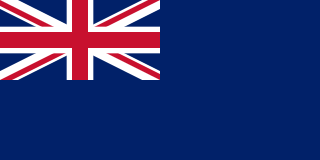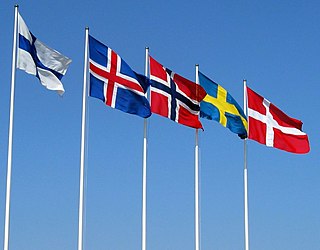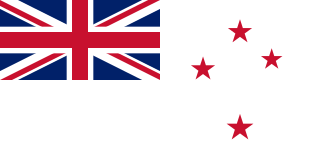
Crux is a constellation of the southern sky that is centred on four bright stars in a cross-shaped asterism commonly known as the Southern Cross. It lies on the southern end of the Milky Way's visible band. The name Crux is Latin for cross. Even though it is the smallest of all 88 modern constellations, Crux is among the most easily distinguished as its four main stars each have an apparent visual magnitude brighter than +2.8. It has attained a high level of cultural significance in many Southern Hemisphere states and nations.
The Southern Cross or Crux is a star group visible mainly in the Southern Hemisphere. It has been known by this English term since the late 18th century.

The Union Jack, or Union Flag, is the de facto national flag of the United Kingdom. Although no law has been passed making the Union Flag the official national flag of the United Kingdom, it has effectively become such through precedent. The Union Flag was also used as the official flag of several British colonies and dominions before they adopted their own national flags. The flag continues to have official status in Canada, by parliamentary resolution, where it is known as the Royal Union Flag.

In British maritime law and custom, an ensign is the identifying flag flown to designate a British ship, either military or civilian. Such flags display the United Kingdom Union Flag in the canton, with either a red, white or blue field, dependent on whether the vessel is civilian, naval, or in a special category. These are known as the red, white, and blue ensigns respectively.

The flag of New Zealand, also known as the New Zealand Ensign, is based on the British maritime Blue Ensign – a blue field with the Union Jack in the canton or upper hoist corner – augmented or defaced with four red stars centred within four white stars, representing the Southern Cross constellation.

The Blue Ensign is a flag, one of several British ensigns, used by certain organisations or territories associated or formerly associated with the United Kingdom. It is used either plain or defaced with a badge or other emblem.

In vexillography, the canton is a rectangular emblem placed at the top left of a flag, usually occupying up to a quarter of a flag's area. The canton of a flag may be a flag in its own right. For instance, British ensigns have the Union Jack as their canton, as do their derivatives such as the national flags of Australia and New Zealand.

The White Ensign, at one time called the St George's Ensign because of the simultaneous existence of a crossless version of the flag, is an ensign worn on British Royal Navy ships and shore establishments. It consists of a red St George's Cross on a white field, identical to the flag of England except with the Union Flag in the upper canton.

The current state flag of New South Wales was officially adopted in 1876. The flag is based on the defaced British Blue Ensign with the state badge located in the fly. The badge, based on the coat of arms, is a white disc with the cross of St George, a golden lion passant guardant in the centre of the cross and an eight-pointed gold star on each arm of the cross.

The state flag of Queensland is a British Blue Ensign with the state badge on a white disc added in the fly. The badge is a light blue Maltese Cross with a Saint Edward's Crown in the centre of the cross. The flag dates from 1876, with minor variations, and the badge was designed by William Hemmant, the Colonial Secretary and Treasurer of Queensland in 1876.

The National Colonial Flag was a forerunner for the many Australian flag designs which featured the Southern Cross and Union Flag in combination. It is the first recorded attempt to design a distinctive national flag for Australia. Designed by Captain John Bingle and Captain John Nicholson, both New South Wales residents, it is inspired by the White Ensign of the Royal Navy, the protector and defender of Australia from 1788 to 1913. The large red cross of St George features four white, eight pointed stars representing the Southern Cross. According to Bingle it was adopted by the Government of Sir Thomas Brisbane, the Governor of New South Wales from 1821 to 1825. The National Colonial Flag was the first flag designed specifically to represent Australia.
Many years ago as far back as 1823 or 1824 I assisted Captain Nicholson RN, the first Harbour Master of Port Jackson, to plan and recommend to the Lords of the Admiralty a National Colonial Flag for Australia which met with their Lordships approval and adopted by the Government of Sir Thomas Brisbane. Our proposition had the British National St George's Ensign adding Four (4) Stars placed in the four quarters of the Cross in the fly of the Ensign as the emblem of our Hemisphere THE GREAT SOUTHERN CROSS. The flag has lately been disfigured by adding another star in the centre of the Cross by someone not comprehending the original intention and embodying American notions. Sydney in those days was Australia ! and no other province to represent so that adding more Stars frustrated the original intention.

A Nordic cross flag is a flag bearing the design of the Nordic or Scandinavian cross, a cross symbol in a rectangular field, with the centre of the cross shifted towards the hoist.

The flag of Australia, also known as the Australian Blue Ensign, is based on the British Blue Ensign—a blue field with the Union Jack in the upper hoist quarter—augmented with a large white seven-pointed star and a representation of the Southern Cross constellation, made up of five white stars. Australia also has a number of other official flags representing its people and core functions of government.
Cruzeiro do Sul is the name of the Southern Cross (Crux) constellation in Portuguese.

Amphibromus is a genus of grasses in the family Poaceae. Most are known as swamp wallaby grass. Most are endemic to Australia. One can also be found in New Zealand and there are two species in South America.

The New Zealand White Ensign is a naval ensign used by ships of the Royal New Zealand Navy (RNZN) from 1968. Based on the Royal Navy's White Ensign, it features the Southern Cross from the New Zealand national flag in place of the Saint George's Cross. One of the earliest flags associated with the country, that used by the United Tribes of New Zealand, was a white ensign. This was replaced by the Union Flag when New Zealand became a British colony. A blue ensign with the Southern Cross was introduced for ships of the colonial government in 1867 and this soon became a de facto national flag. Ships in New Zealand naval service wore the Royal Navy's White Ensign until 1968 when the distinct New Zealand White Ensign was introduced. The ensign was implemented out of a desire to distinguish New Zealand vessels from those of the Royal Navy and this decision is regarded as an important step in the development of the RNZN.


















































































































